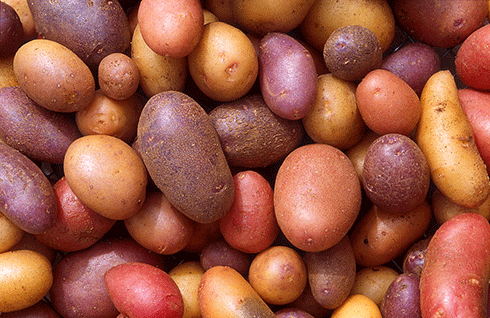
|
Published: 11 March 2014
Too much of the same bodes ill for world’s food future
A comprehensive study of global food supplies confirms what experts have long suspected: over the last five decades, human diets around the world have grown ever more similar – by a global average of 36 per cent – and the trend shows no signs of slowing, with major consequences for human nutrition and global food security.

|
|
In many developing countries, rice and local crops are being replaced by wheat and potatoes – both staples of the developed world. Credit:
Scott Bauer, USDA ARS
|
‘More people are consuming more calories, protein and fat, and they rely increasingly on a short list of major food crops, like wheat, maize and soybean, along with meat and dairy products, for most of their food,’ said lead author Colin Khoury, a scientist at the Colombia-based International Center for Tropical Agriculture (CIAT), a member of the international agricultural R&D consortium, CGIAR.
‘These foods are critical for combating world hunger, but relying on a global diet of such limited diversity obligates us to bolster the nutritional quality of the major crops, as consumption of other nutritious grains and vegetables declines.’
The new study, published in the Proceedings of the National Academy of Sciences, suggests that growing reliance on a few food crops may also accelerate the worldwide rise in obesity, heart disease and diabetes, which are strongly affected by dietary change and have become major health problems, even within countries still grappling with significant constraints in food availability.
The study calls for urgent efforts to better inform consumers about diet-related diseases and to promote healthier, more diverse food alternatives.
The research reveals that the crops now predominant in diets around the world include several that were already quite important a half-century ago – such as wheat, rice, maize and potato.
But the emerging ‘standard global food supply’ described by the study also consists of energy-dense foods that have risen to global fame more recently, like soybean, sunflower oil and palm oil. Wheat is a major staple in 97.4 per cent of countries and rice in 90.8 per cent; soybean has become significant to 74.3 per cent of countries.
In contrast, many crops of considerable regional importance – including cereals like sorghum, millets and rye, as well as root crops such as sweet potato, cassava and yam – have lost ground. Other locally significant grain and vegetable crops – for which globally comparable data are not available – have suffered the same fate. For example, a nutritious tuber crop known as ‘oca’, once grown widely in the Andean highlands, has declined significantly in this region both in cultivation and consumption.
‘Another danger of a more homogeneous global food basket is that it makes agriculture more vulnerable to major threats like drought, insect pests and diseases, which are likely to become worse in many parts of the world as a result of climate change,’ said Luigi Guarino, a study co-author and senior scientist at the Global Crop Diversity Trust.
‘As the global population rises and the pressure increases on our global food system, so does our dependence on the global crops and production systems that feed us. The price of failure of any of these crops will become very high.’
Rising incomes in developing countries have enabled more consumers to include larger quantities of animal products, oils and sugars in their diets. Moreover, urbanisation in these countries has encouraged greater consumption of processed and fast foods.
Related developments, including trade liberalisation, improved commodity transport, multinational food industries, and food safety standardisation have further reinforced these trends.
The researchers single out five actions that are needed to foster diversity in food production and consumption and thus improve nutrition and food security:
-
Actively promote the adoption of a wider range of varieties of the major crops worldwide, such as banana, to boost genetic diversity.
-
Support the conservation and use of diverse plant genetic resources – including farmers' traditional varieties and wild species related to crops.
-
Enhance the nutritional quality of the major crops on which people depend – for example, through crop breeding to improve the content of micronutrients like iron and zinc.
-
Promote alternative crops that can boost the resilience of farming and make human diets healthier through research aimed at making these crops more competitive in domestic and international markets.
-
Foster public awareness of the need for healthier diets, based on better decisions about what and how much we eat as well as the forms in which we consume food.
Source: CGIAR



